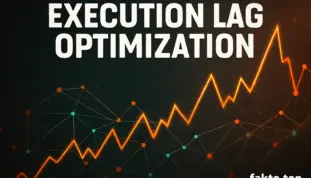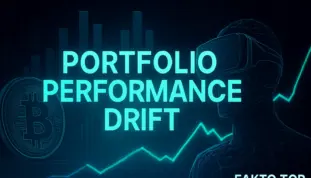Copy Trading Optimization: How to Eliminate Portfolio Performance Drift
Is Your Profit Lagging? Copy Trading Optimization Guide to Eliminating Performance Drift
The Performance Drift Paradox: Why Your 20% Return is Only 12%
Copy trading promises simplicity—mirror the trades of a successful master and enjoy similar returns. But in practice, many followers experience a frustrating gap between expected and actual performance. This discrepancy, known as copy trading portfolio drift, is often caused by subtle but critical technical and structural issues.

This guide is designed to help intermediate and advanced copy traders diagnose and eliminate that drift. We’ll walk through the three primary culprits: execution lag optimization, minimum trade size impact, and hidden costs like slippage and gas fees. Optimization requires active management—not passive hope.
If you need to review the steps for initial platform selection and basic setup, refer to our guide on Basic Copy Trading.
Phase 1: Technical Debugging to Eliminate Execution Lag
The Hidden Cost of Gas Fee Erosion (Gas Fee Erosion in Copy Trading)
In decentralized or hybrid copy trading systems, gas costs and transaction fees can compound into one of the most significant sources of portfolio drift—a phenomenon known as Gas Fee Erosion in Copy Trading. In high-frequency strategies operating on narrow profit margins, execution fees can rapidly outweigh the gross gains from mirrored trades. This issue is particularly acute in Layer 1 (L1) settlements.
L1/L2 Technical Solution:
The core distinction between Layer 1 and Layer 2 networks lies in transaction cost predictability and settlement efficiency. Layer 1 networks (such as the Ethereum mainnet) require validators to process each transaction individually, which exposes traders to variable fees and network congestion—an especially damaging combination for low-margin or high-frequency strategies. In contrast, Layer 2 solutions (including sidechains and optimistic or zero-knowledge rollups) aggregate thousands of off-chain transactions into a single proof submitted to the Layer 1 network. This architecture significantly reduces per-trade execution costs, mitigating gas fee erosion and enabling high-frequency trading strategies to remain economically viable.
Action:
Perform a comprehensive audit of your trade logs. If the average net profit per trade is less than three times the execution fee, the strategy is mathematically unsustainable given your capital allocation. Such results typically indicate a substantial trade size mismatch. For additional insights into how Layer 1 and Layer 2 mechanics influence execution efficiency and transaction costs, refer to our Crypto Mechanics Foundation guide.

Execution Drift Diagnostic
| Problem/Symptom | Primary Cause | Technical Fix (Immediate) | Structural Fix (Long-Term) |
|---|---|---|---|
| Price Mismatch | Execution Lag / Asynchronous Execution | Increase funding to ensure deeper liquidity depth for order queueing. | Move to a platform with L2 or near-synchronous execution. |
| Missed Trades | Minimum Trade Size Threshold | Manually increase copy capital to exceed the platform’s minimum sizing requirement. | Select master traders who use larger, more predictable position sizes. |
| High Fee Impact | High-Frequency Trading on L1 / Fee structure | Filter for low-frequency or swing strategies. | Choose platforms with fixed fees or L2 settlement options. |
Phase 2: Financial Tuning & Correcting Allocation Drift
The Dynamics of Proportional Sizing Adjustment
One of the most overlooked errors in copy trading is fixed-amount copying. This approach ignores the follower’s changing capital and the master’s dynamic exposure. Instead, traders must adopt proportional sizing adjustment, where each trade is mirrored as a percentage of total AUM.
Action: Apply copy trading sizing correction whenever capital is added, withdrawn, or platform settings reset. Without this, your portfolio will drift from the master’s intent.
Auditing Capital Allocation Discrepancies
The master’s AUM often remains static, but the follower’s fluctuates due to profits, losses, and fees. This leads to allocation drift, where the follower’s exposure no longer matches the master’s.
Action: Perform a weekly or bi-weekly audit to confirm that your allocated capital still reflects the intended copy ratio. This is the essence of follower AUM rebalancing.
The Hidden Cost of Gas Fee Erosion
In high-frequency or low-margin strategies, small fees—gas, spread, platform sharing—can silently erode profits. This is especially true on Layer 1 chains with volatile fee structures.

Action: Conduct a trade size mismatch audit. If your average net gain per trade is less than 3× the execution fee, the strategy is unsustainable. For deeper context on how Layer 1 vs. Layer 2 mechanics and gas fees affect performance, refer to our guide on Crypto Mechanics Foundation.
This step is essential for mitigating gas fee erosion copy trading and ensuring long-term viability.
Portfolio Audit & Intervention Triggers
| Audit Metric | Warning Threshold | Recommended Action | Risk-First Rationale |
|---|---|---|---|
| Performance Drift | Follower PnL is ≥7% less than Master PnL (over 30D) | Initiate Follower AUM Rebalancing (recalculate and reset copy ratio). | Corrects structural sizing errors before compounding. |
| Master’s Max Drawdown | Master exceeds historical Max Drawdown by >10% | Temporarily pause copying or reduce allocated capital by 50%. | Protects capital against psychological failure or strategy burnout. |
| Fee/Profit Ratio | Fees (Gas + Sharing) exceed 20% of Gross Profit | Audit trade frequency; switch to a platform with lower Gas Fee Erosion. | Stops the passive drain of small gains due to execution costs. |
Phase 3: Risk-First Auditing and Intervention Triggers
Defining Your Hard Stop: The Follower’s Independent Max Drawdown
Copy trading doesn’t absolve you from risk management. The follower must define a personal Hard Stop-Loss—an absolute capital preservation threshold—regardless of the master’s discipline. This protects against platform failure, execution error, or extreme follower vs master return discrepancy.
Action: Set a maximum drawdown limit on your allocated portfolio. Never rely solely on the master’s stop-loss logic.
When to Pull the Plug: Identifying Intervention Triggers
Optimization isn’t just about tuning—it’s about knowing when to intervene. Define clear, measurable triggers for pausing or unfollowing a master trader:
- Performance Drift exceeds 7% over a 30-day period.
- Master suddenly increases leverage or shifts to low-liquidity assets.
- Master’s trade frequency spikes unexpectedly, indicating strategy instability.
These signals are your lifeline. Use them to protect capital before damage compounds.
Conclusion: Copy Trading is Active Management, Not Passive Income
Success in copy trading isn’t about blind following—it’s about optimizing your end of the equation. From execution lag optimization to follower AUM rebalancing, every detail matters. Continuous auditing, debugging, and intervention are mandatory. Treat your portfolio like a system—because it is one.

1 Comment on "Copy Trading Optimization: How to Eliminate Portfolio Performance Drift"
I just read an article that finally explained why my portfolio never matches the returns I calculate. It showed how volatility and compounding quietly eat into what looks like a solid 20% gain. I’ve been in crypto long enough to know numbers can be misleading, but this piece really nailed the math behind it. Simple, sharp, and very real — now I’ll never look at my performance charts the same way again.